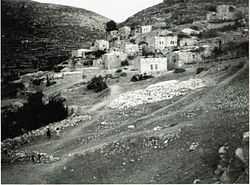Nisf Jubeil
| Nisf Jubeil | |
|---|---|
| Other transcription(s) | |
| • Arabic | لﻴﺒﺠ ﻑﺼِﻨ |
| • Also spelled |
Nisf Jbeil (official) Nisf Jubayl (unofficial) |
 | |
 Nisf Jubeil | |
| Coordinates: 32°16′58″N 35°13′14″E / 32.28278°N 35.22056°ECoordinates: 32°16′58″N 35°13′14″E / 32.28278°N 35.22056°E | |
| Governorate | Nablus |
| Government | |
| • Type | Local Development Committee |
| • Head of Municipality | Adil Barakat[1] |
| Population (2007) | |
| • Jurisdiction | 394 |
| Name meaning | "The Watershed"[2] |
Nisf Jubeil (Arabic: لﻴﺒﺠ ﻑﺼِﻨ also spelled Nisf Jbeil or Nisf Jubayl) is a Palestinian village in the Nablus Governorate in the northern West Bank, located northwest of Nablus. According to the Palestinian Central Bureau of Statistics (PCBS) census, it had a population of 394 in 2007. There were a total of 83 households and 17 business establishments.[3]
Geography
Nisf Jubeil is situated on a terrace along the Wadi Nib outlet of the Sebastiya Valley, with an approximate elevation of 400 meters above sea level. It is 2.5 kilometers east of the town of Sebastia.[4] Other nearby localities include Ijnisinya to the south, Yasid to the east and Beit Imrin to the north.[5] The nearby Ein Sharqiya spring serves as a source of water and there are 30 cisterns in the village.[4]
History
Nisf Jubeil had been a Crusader village called "Casale Seingebis" belonging to the territory of Caesarea in the early 13th-century.[4] In 1207 the Knights Hospitallers were granted the village by Lady Juliana of Caesarea along with nearby Far'un.[6]
In 1596, it appeared in Ottoman tax registers as "Jubayl", a village in the nahiya of Jabal Sami in the liwa of Nablus. It had a population of 30 Muslim households and 36 Christian households, and paid taxes on wheat, barley, summer crops, olive trees, goats and beehives.[7]
In 1838 there were approximately 200 Christians, including a priest living in the village.[8][9] Victor Guérin found an ancient sarcophage in Nisf Jubeil, used as a trough. He estimated there were 300 inhabitants, including some Christians.[10] In 1882, Nisf Jubeil was described as "A small village in an open valley, with a spring to the east and olives. Some of the inhabitants are Greek Christians."[11] "Foundations on a hill" was listed among archaeological finds.[12] In 1922 its population was 162 (including 88 Christians)[9] increasing to 210 (including 105 Christians[13]) in the 1931 census by the British Mandate of Palestine.[1] Nisf Jubeil has a mixed population of Christians and Muslims.[14]
Its total land area in 1945 was recorded as 5,054 dunams.[15] In 1979 Nisf Jubeil's built-up area amounted to 25 dunams. Its village center contained a few old houses, two Greek Orthodox churches and a mosque,[4] called the Nisf Jubeil Mosque.[16] The mayor of the village is currently Adil Barakat.[1]
References
| Wikimedia Commons has media related to Nisf Jubeil. |
- ↑ 1.0 1.1 1.2 Nisf Jubeil Profile. Jerusalem Media and Communication Center.
- ↑ Palmer 1881, p. 187
- ↑ 2007 PCBS Census. Palestinian Central Bureau of Statistics. p. 108.
- ↑ 4.0 4.1 4.2 4.3 Zertal, 2004, p. 451.
- ↑ Map of Nisf Jubayl. Google Maps. Map depicts various localities surrounding Nisf Jubeil.
- ↑ Boas, 2006, p. 82.
- ↑ Hütteroth and Abdulfattah, 1977, p. 129.
- ↑ Barron, 1923, Table IX, Sub-district of Nablus, p. 24
- ↑ 9.0 9.1 Ellenblum, 2003, p. 249.
- ↑ Guerin, 1875, p. 210
- ↑ Conder and Kitchener, 1882, p. 160
- ↑ Conder and Kitchener, 1882, p. 210
- ↑ Mills, 1932, 1931 British Mandate Census. p. 63.
- ↑ Saadeh, Youssef Jubran. Christianity in Nablus. Zajel. 2004-06-27.
- ↑ Government of Palestine, Department of Statistics. Village Statistics, April, 1945. Quoted in S. Hadawi, Village Statistics, 1945. PLO Research Center, 1970, p60.
- ↑ Supplementary List of Moslem Holy Places in Palestine outside the area of Jerusalem. United Nations Conciliation Commission for Palestine. 1949-11-28.
Bibliography
- Barron, J. B., ed. (1923). Palestine: Report and General Abstracts of the Census of 1922. Government of Palestine.
- Boas, Adrian J. (2006). Archaeology of the Military Orders: A Survey of the Urban Centres, Rural Settlement and Castles of the Military Orders in the Latin East (c. 1120-1291). Taylor & Francis. ISBN 0415299802.
- Conder, Claude Reignier; Kitchener, H. H. (1882). The Survey of Western Palestine: Memoirs of the Topography, Orography, Hydrography, and Archaeology 2. London: Committee of the Palestine Exploration Fund.
- Ellenblum, Ronnie (2003). Frankish Rural Settlement in the Latin Kingdom of Jerusalem. Cambridge University Press. ISBN 0521521874.
- Guérin, Victor (1875). Description Géographique Historique et Archéologique de la Palestine. Vol 2; Samarie, pt. 2.
- Hütteroth, Wolf-Dieter; Abdulfattah, Kamal (1977). Historical Geography of Palestine, Transjordan and Southern Syria in the Late 16th Century. Erlanger Geographische Arbeiten, Sonderband 5. Erlangen, Germany: Vorstand der Fränkischen Geographischen Gesellschaft.
- Mills, E., ed. (1932). Census of Palestine 1931. Population of Villages, Towns and Administrative Areas. Jerusalem: Government of Palestine.
- Palmer, E. H. (1881). The Survey of Western Palestine: Arabic and English Name Lists Collected During the Survey by Lieutenants Conder and Kitchener, R. E. Transliterated and Explained by E.H. Palmer. Committee of the Palestine Exploration Fund.
- Zertal, Adam (2004). The Manasseh Hill Country Survey 1. Boston: BRILL. ISBN 9004137564.
External links
| ||||||||||||||||
